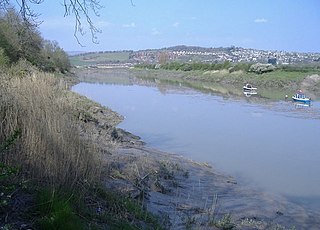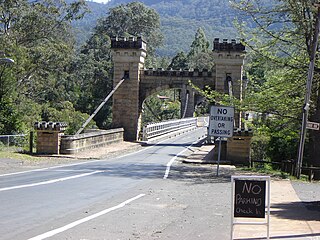
A suspension bridge is a type of bridge in which the deck is hung below suspension cables on vertical suspenders. The first modern examples of this type of bridge were built in the early 1800s. Simple suspension bridges, which lack vertical suspenders, have a long history in many mountainous parts of the world.

A cable-stayed bridge has one or more towers, from which cables support the bridge deck. A distinctive feature are the cables or stays, which run directly from the tower to the deck, normally forming a fan-like pattern or a series of parallel lines. This is in contrast to the modern suspension bridge, where the cables supporting the deck are suspended vertically from the main cable, anchored at both ends of the bridge and running between the towers. The cable-stayed bridge is optimal for spans longer than cantilever bridges and shorter than suspension bridges. This is the range within which cantilever bridges would rapidly grow heavier, and suspension bridge cabling would be more costly.

The River Usk rises on the northern slopes of the Black Mountain, Wales, in the westernmost part of the Brecon Beacons National Park. Initially forming the boundary between Carmarthenshire and Powys, it flows north into Usk Reservoir, then east by Sennybridge to Brecon before turning southeast to flow by Talybont-on-Usk, Crickhowell and Abergavenny, after which it takes a more southerly course.

A crane is a machine used to move materials both vertically and horizontally, utilizing a system of a boom, hoist, wire ropes or chains, and sheaves for lifting and relocating heavy objects within the swing of its boom. The device uses one or more simple machines, such as the lever and pulley, to create mechanical advantage to do its work. Cranes are commonly employed in transportation for the loading and unloading of freight, in construction for the movement of materials, and in manufacturing for the assembling of heavy equipment.

Newport is a city and county borough in Wales, situated on the River Usk close to its confluence with the Severn Estuary, 12 mi (19 km) northeast of Cardiff. With a population of 145,700 at the 2011 census, Newport is the third-largest principal authority with city status in Wales, and seventh most populous overall. Newport became a unitary authority in 1996 and forms part of the Cardiff-Newport metropolitan area, also known as the Cardiff Capital Region. Newport was the site of the last large-scale armed insurrection in Great Britain, the Newport Rising of 1839. The population grew considerably between the 2011 and the 2021 census, rising to 159,587, the largest growth of any unitary authority in Wales.

Torre de Collserola is a uniquely designed tower located on the Tibidabo hill in the Serra de Collserola, in Barcelona, Catalonia, Spain. It was designed by the architect Sir Norman Foster and by the Spanish civil engineers Julio Martínez Calzón and Manuel Julià Vilardell. This emblematic tower was built in 1991 by the construction company Cubiertas y MZOV S.A. for the 1992 Summer Olympics. It features a pod for floor space like many towers but uses guy wires for lateral support like a mast. Mainly used as a TV and radio transmitter, this futuristic design provides the highest viewpoint over the city. The top antenna reaches 288.4 m (946 ft) and the top of the pod, which has thirteen floors, reaches 152 m (499 ft). The highest point of this tower is the highest place one could be in the city of Barcelona. The tenth floor of the pod is open to the public.

Chelsea Bridge is a bridge over the River Thames in west London, connecting Chelsea on the north bank to Battersea on the south bank, and split between the City of Westminster, the London Borough of Wandsworth and the Royal Borough of Kensington and Chelsea. There have been two Chelsea Bridges, on the site of what was an ancient ford.

The Millau Viaduct is a multispan cable-stayed bridge completed in 2004 across the gorge valley of the Tarn near Millau in the Aveyron department in the Occitanie Region, in Southern France. The design team was led by engineer Michel Virlogeux and English architect Norman Foster. As of October 2023, it is the tallest bridge in the world, having a structural height of 336.4 metres (1,104 ft).

The Newport Transporter Bridge is a transporter bridge that crosses the River Usk in Newport, South East Wales. The bridge is the lowest crossing on the River Usk. It is a Grade I listed structure.

The Nordhordland Bridge is a combined cable-stayed and pontoon bridge which crosses Salhusfjorden between Klauvaneset and the island of Flatøy in Vestland county, Norway. It is 1,614 meters (5,295 ft) long, of which the pontoon section is 1,246 meters (4,088 ft) long. The cable-stayed section consists of a single 99-meter (325 ft) tall H-pylon which has a length of 368 meters (1,207 ft) and a main span of 172 meters (564 ft). This allows for a clearance of 32 meters (105 ft).

Hampden Bridge is a heritage-listed single-span suspension bridge that carries Moss Vale Road (B73) across the Kangaroo River, in Kangaroo Valley, in the City of Shoalhaven local government area of New South Wales, Australia. The bridge was designed by Ernest de Burgh and built by Loveridge and Hudson. The property is owned by Transport for NSW. It was added to the New South Wales State Heritage Register on 2 August 2019.

Newport city centre is traditionally regarded as the area of Newport, Wales bounded by the west bank of the River Usk, the George Street Bridge, the eastern flank of Stow Hill and the South Wales Main Line. Most of the city centre is contained within two conservation areas: the central area and the area around Lower Dock Street. Most of the city centre is located in the Stow Hill district.
David Rowell & Co. was a company based in Westminster, London that fabricated wrought iron and wire rope, built suspension footbridges, and structural steel frame buildings. They were established in 1855 and closed in 1970.

The Denver Millennium Bridge is the world's first cable-stayed bridge using post-tensioned structural construction. Located near LoDo, in Riverfront Park, it connects the 16th Street Mall with the Commons Park in the Central Platte Valley District of the Union Station neighborhood. The bridge is one of three pedestrian bridges between Downtown Denver and the Highland neighborhood.

The Hulme Arch Bridge in Hulme, Manchester, England, supports Stretford Road as it passes over Princess Road, and is located at grid reference SJ838968. The construction of the bridge formed part of the regeneration of the Hulme district of Manchester, both by re-establishing the former route of Stretford Road, which had been cut into two halves by the construction of Princess Road in 1969, and by providing a local landmark. The location was previously occupied by a footbridge.

The Infinity Bridge is a public pedestrian and cycle footbridge across the River Tees in the borough of Stockton-on-Tees in northern England. The bridge is situated one kilometre downriver of Stockton town centre, between the Princess of Wales Bridge and the Tees Barrage. It connects the Teesdale Business Park and the University of Durham's Queen's Campus in Thornaby-on-Tees on the south bank of the Tees with the Tees Valley Regeneration's £320 million North Shore development on the north bank.
Spider Bridge at Falls of Schuylkill was an iron-wire footbridge erected in 1816 over the Schuylkill River, north of Philadelphia, Pennsylvania. Though a modest and temporary structure, it is thought to have been the first wire-cable suspension bridge in the world.

The Media City Footbridge is a swing-mechanism footbridge over the Manchester Ship Canal near MediaCityUK. It is an asymmetric cable-stayed swing bridge and was completed in 2011. It was designed by Gifford and Wilkinson Eyre.

The New Portland Wire Bridge is a historic suspension bridge in New Portland, Maine. The bridge carries Wire Bridge Road across the Carrabassett River a short way north of the village center. Built in the mid-19th century, it is one of four 19th-century suspension bridges in the state. It is one lane wide, and has a weight limit of 3 tons. The bridge was listed on the National Register of Historic Places in 1970 and was designated as a Maine Historic Civil Engineering Landmark by the American Society of Civil Engineers in 1990.

Baring Bridge is a one-lane wood and steel cable suspension bridge crossing the South Fork Skykomish River in Baring, Washington, United States. It carries Index Creek Road, which connects a rural area to U.S. Route 2 in unincorporated King County. Built in 1930, it is one of only two wooden suspension bridges designed for vehicle use in Washington that remain active and was added to the National Register of Historic Places in August 2019.























